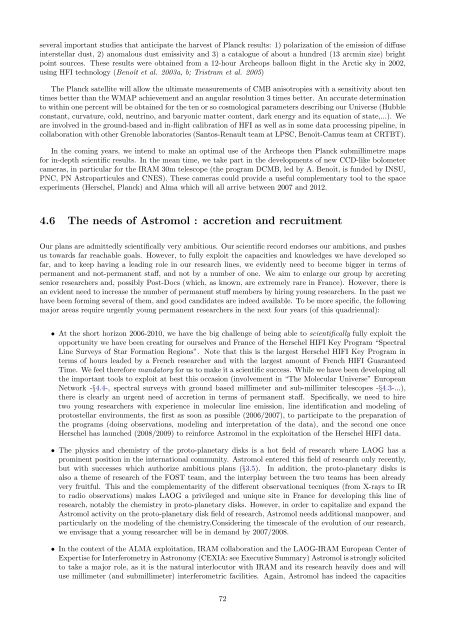Untitled - Laboratoire d'Astrophysique de l'Observatoire de Grenoble
Untitled - Laboratoire d'Astrophysique de l'Observatoire de Grenoble
Untitled - Laboratoire d'Astrophysique de l'Observatoire de Grenoble
Create successful ePaper yourself
Turn your PDF publications into a flip-book with our unique Google optimized e-Paper software.
several important studies that anticipate the harvest of Planck results: 1) polarization of the emission of diffuse<br />
interstellar dust, 2) anomalous dust emissivity and 3) a catalogue of about a hundred (13 arcmin size) bright<br />
point sources. These results were obtained from a 12-hour Archeops balloon flight in the Arctic sky in 2002,<br />
using HFI technology (Benoît et al. 2003a, b; Tristram et al. 2005)<br />
The Planck satellite will allow the ultimate measurements of CMB anisotropies with a sensitivity about ten<br />
times better than the WMAP achievement and an angular resolution 3 times better. An accurate <strong>de</strong>termination<br />
to within one percent will be obtained for the ten or so cosmological parameters <strong>de</strong>scribing our Universe (Hubble<br />
constant, curvature, cold, neutrino, and baryonic matter content, dark energy and its equation of state,...). We<br />
are involved in the ground-based and in-flight calibration of HFI as well as in some data processing pipeline, in<br />
collaboration with other <strong>Grenoble</strong> laboratories (Santos-Renault team at LPSC, Benoît-Camus team at CRTBT).<br />
In the coming years, we intend to make an optimal use of the Archeops then Planck submillimetre maps<br />
for in-<strong>de</strong>pth scientific results. In the mean time, we take part in the <strong>de</strong>velopments of new CCD-like bolometer<br />
cameras, in particular for the IRAM 30m telescope (the program DCMB, led by A. Benoît, is fun<strong>de</strong>d by INSU,<br />
PNC, PN Astroparticules and CNES). These cameras could provi<strong>de</strong> a useful complementary tool to the space<br />
experiments (Herschel, Planck) and Alma which will all arrive between 2007 and 2012.<br />
4.6 The needs of Astromol : accretion and recruitment<br />
Our plans are admittedly scientifically very ambitious. Our scientific record endorses our ambitions, and pushes<br />
us towards far reachable goals. However, to fully exploit the capacities and knowledges we have <strong>de</strong>veloped so<br />
far, and to keep having a leading role in our research lines, we evi<strong>de</strong>ntly need to become bigger in terms of<br />
permanent and not-permanent staff, and not by a number of one. We aim to enlarge our group by accreting<br />
senior researchers and, possibly Post-Docs (which, as known, are extremely rare in France). However, there is<br />
an evi<strong>de</strong>nt need to increase the number of permanent stuff members by hiring young researchers. In the past we<br />
have been forming several of them, and good candidates are in<strong>de</strong>ed available. To be more specific, the following<br />
major areas require urgently young permanent researchers in the next four years (of this quadriennal):<br />
• At the short horizon 2006-2010, we have the big challenge of being able to scientifically fully exploit the<br />
opportunity we have been creating for ourselves and France of the Herschel HIFI Key Program “Spectral<br />
Line Surveys of Star Formation Regions”. Note that this is the largest Herschel HIFI Key Program in<br />
terms of hours lea<strong>de</strong>d by a French researcher and with the largest amount of French HIFI Guaranteed<br />
Time. We feel therefore mandatory for us to make it a scientific success. While we have been <strong>de</strong>veloping all<br />
the important tools to exploit at best this occasion (involvement in “The Molecular Universe” European<br />
Network -§4.4-, spectral surveys with ground based millimeter and sub-millimiter telescopes -§4.3-...),<br />
there is clearly an urgent need of accretion in terms of permanent staff. Specifically, we need to hire<br />
two young researchers with experience in molecular line emission, line i<strong>de</strong>ntification and mo<strong>de</strong>ling of<br />
protostellar environments, the first as soon as possible (2006/2007), to participate to the preparation of<br />
the programs (doing observations, mo<strong>de</strong>ling and interpretation of the data), and the second one once<br />
Herschel has launched (2008/2009) to reinforce Astromol in the exploitation of the Herschel HIFI data.<br />
• The physics and chemistry of the proto-planetary disks is a hot field of research where LAOG has a<br />
prominent position in the international community. Astromol entered this field of research only recently,<br />
but with successes which authorize ambitious plans (§3.5). In addition, the proto-planetary disks is<br />
also a theme of research of the FOST team, and the interplay between the two teams has been already<br />
very fruitful. This and the complementarity of the different observational tecniques (from X-rays to IR<br />
to radio observations) makes LAOG a privileged and unique site in France for <strong>de</strong>veloping this line of<br />
research, notably the chemistry in proto-planetary disks. However, in or<strong>de</strong>r to capitalize and expand the<br />
Astromol activity on the proto-planetary disk field of research, Astromol needs additional manpower, and<br />
particularly on the mo<strong>de</strong>ling of the chemistry.Consi<strong>de</strong>ring the timescale of the evolution of our research,<br />
we envisage that a young researcher will be in <strong>de</strong>mand by 2007/2008.<br />
• In the context of the ALMA exploitation, IRAM collaboration and the LAOG-IRAM European Center of<br />
Expertise for Interferometry in Astronomy (CEXIA: see Executive Summary) Astromol is strongly solicited<br />
to take a major role, as it is the natural interlocutor with IRAM and its research heavily does and will<br />
use millimeter (and submillimeter) interferometric facilities. Again, Astromol has in<strong>de</strong>ed the capacities<br />
72




